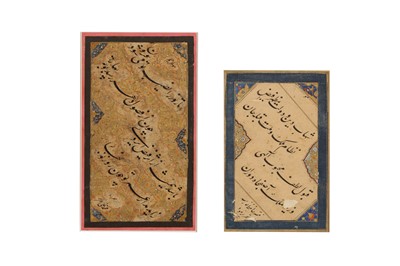29th Apr, 2022 11:00
Islamic Art - Property of a European Collector Part III
TWO MURAQQA' ALBUM PAGES OF NASTA'LIQ CALLIGRAPHY
Deccan, Central India, 18th century
TWO MURAQQA' ALBUM PAGES OF NASTA'LIQ CALLIGRAPHY
PROPERTY FROM AN IMPORTANT EUROPEAN PRIVATE COLLECTION
Deccan, Central India, 18th century
Comprising two pages of Persian manuscripts on paper, both with 4ll. of black ink nasta’liq script in chalipa format, one ruba'i set in cloudbands against a densely illuminated ground with polychrome flower buds and foliage, and gold scrolling vines, signed at the bottom Muhammad Taqi 125 AH (possibly 1125 AH - 1713 AD - or 1205 AH - 1790 AD), set within black borders on pink paper, in a double mount, framed and glazed, the text panel 18.8cm x 9.8cm, 40.2cm x 29cm including the frame; and another similar, eulogising the Asaf Jahi minister Shahab ud-Din, decorated with typical cusped cartouches filled with polychrome floral sprays on either blue or gold grounds, signed at the bottom Hafez Nour Ullah, the text panel 14cm x 8cm, 38.5cm x 31.4cm including the frame.
These calligraphic compositions are of particular relevance to the arts of India in the Persianate Age, especially the Deccan region. The first panel is signed by Muhammad Taqi. At the time, this must have been a rather common name and calligraphers' takhallos, but it seems worthy to mention here that a famous calligrapher and manuscript illuminator by the name of Muhammad Taqi was the Iranian emigre Ibn Mahmud Muhammad Taqi al-Shirazi who worked in Nauraspur (Deccan) for Ibrahim Adil Shah II (1570 - 1627). Should the date on the panel be interpreted as 1025 AH (1616 AD), instead of 1125 or 1205 AH, this would set our calligraphic composition in the time period when he was active at the Adil Shahi court. Stylistically speaking, the chalipa quatrains present several analogies to calligraphic compositions attributed to Persian calligraphers active in the Deccan region. The second panel mentions the minister Shahab ud-Din of the Asaf Jahi dynasty. Better known as the Nizams of Hyderabad, the Asaf Jahis were a Muslim dynasty that, after settling in India in the late 17th century, became employees of the Mughal Empire and ruled the kingdom of Hyderabad from 1724 until 1948.
Sold for £525
Includes Buyer's Premium
Do you have an item similar to the item above? If so please click the link below to submit a free online valuation request through our website.



